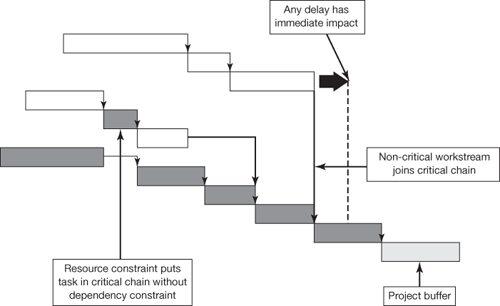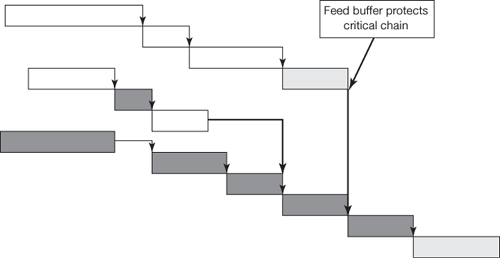Focus on critical activities
|
|
Although critical chain can add much value in planning a project by handling uncertainty more efficiently, it is in helping managers to understand and focus on the critical activities that it has the greatest day-to-day impact during a project. Because the name 'critical chain' sounds similar to 'critical path', it is tempting to think that they are the same. The critical chain includes all the critical path activities, but whereas the critical path is defined only by task dependencies, the critical chain is defined by both task dependencies and resource dependencies. In other words, it recognizes that the minimum time to complete a project can be driven as much by the limited availability of resources as by task sequencing. Activities not on the critical path can form part of the critical chain if they rely on resources which are in demand elsewhere, and any change in their duration has an impact on the project duration. Much of the thrust of the critical chain method is directed towards protecting the critical chain: anything that affects the critical chain affects the project. The key techniques of critical chain are feed buffers, resource buffers, and eliminating multitasking. Feed buffersNon-critical activities must never be allowed to impact on the critical chain. This might happen, for example, when a critical chain activity depends on a non-critical activity that suffers a delay. Critical chain inserts a feed buffer between the non-critical workstream and the critical chain task, so as to insulate the critical chain from the uncertainty in the non-critical workstream timing. This feed buffer is calculated in the same way as for the project buffer, but covers only the tasks on the joining workstream (see Figures A.6 and A.7).
Figure A.6. Activities merging onto critical chain
Figure A.7. Feed bufferUsing feed buffers to protect the critical chain from the non-critical activities frees the project manager from having to use early-start scheduling. (Early-start scheduling means starting all activities as soon as possible, even if they are not critical.) During the early days of a project it is often better not to be distracted by having to start many activities at once, and project managers should focus on the critical chain activity that starts the project. Resource buffersThe critical chain activities must always have all of their resources and inputs available as soon as the preceding task finishes. The simplest form of resource buffer is a reminder flag in the project plan to reconfirm resource availability before the start of each task. When the project depends on another project to release the critical resource on time, it is necessary to include a real buffer period between the tasks on each project. Resource buffers can even take the form of spare or standby staff who are deliberately not assigned to other activities, or, in the case of sub-contract suppliers, cash payments for holding their own staff on instant availability. Eliminating multitaskingThe strict discipline of the focus on the critical chain requires that people should not try to do two tasks at once, especially if one of them is a critical chain activity. In Figure A.8, all three activities are delivered simultaneously through multitasking, but if resources are allowed to prioritize and do one task at a time, two of the three tasks are delivered early and the third no later than through multitasking.
Figure A.8. Multitasking |
|
Top of Page



